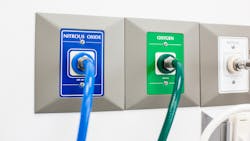Myth busters: I shouldn’t work around nitrous oxide
I can’t work around nitrous oxide because it's dangerous for my pregnancy, right? Wrong!
Most of the research on nitrous oxide was done before we started using a scavenging system. Back in the day when a patient on nitrous oxide exhaled, the gas was simply released into the room air. Now we use mandatory scavenging systems that remove exhaled gases and carry them safely out of the building. The Occupational Safety and Health Administration (OSHA) has never established a “limit” on nitrous oxide for workers.
The written works on this topic suggest there are several contributing factors and some considerations for the research. Most of the research on the detrimental effects of nitrous oxide—including increased liver disease, increased cancer, and decreased bone marrow—were done years ago when safety measures were practically nonexistent and before we implemented the scavenging system.
There has been so much progress on this that nitrous oxide is now used in delivery rooms. A few years ago, doctors started placing expectant mothers on the gas to relax them for childbirth. No detrimental effects have been experienced by mothers or babies.
More myth busters
X-rays are just a way to pad the bill
It’s time to leave dental assisting
Wearing those ‘stupid’ utility gloves
What to do in your office
Maintenance is important, so checking your machine regularly and some other steps are imperative to make sure it’s properly working.
- Check the tubing. Our disinfectants are harmful for a reason—because it’s disinfect! They’re also hard on the rubber for hoses, so be sure to regularly make sure there are no cracks or leaks in the tubing.
- Check your reservoir bag. The breathing bag generally expands and contracts while the gases are flowing. Take the bag off and stretch it. You should be able to pull on it easily. If the bag breaks, it had a rip in it, and you found the rip! It’s good to have a maintenance program and to check your system every three months.
- Ask the maintenance people for help. There are neat little machines that can detect if your gases are leaking. Periodically ask the maintenance people to check this. Leakage is a concern, so make sure your scavenger is working properly. Remember to keep a log of how often you do this and what the outcome is.
- The tubing is autoclavable. Many people stopped using this during COVID-19, but the tubing can all be packaged up and thrown in the autoclave. Just be sure you clean it well before you do this.
- Select the right size nasal hood. I’m picky when it comes to nitrous oxide nasal hoods, and I definitely have a favorite. Choosing the right size, no matter the brand, will ensure little or no leakage.
- Stop the conversation. This is hard to control. Make sure your patients know before you put them under that they cannot talk excessively. This is easier said than done, I know. Talking blows the gases into the room air, which is not what we want.
- Have proper ventilation. Make sure you have the proper ventilation and air flow in the rooms where nitrous is being employed.
- Follow the protocol. Follow the protocol for repertory protection outlined by OSHA. Nitrous oxide is heavy gas, and most of it will flow to the floor upon exhale. If you’re worried about how much you’re breathing in, you can always get a nitrous oxide dosimeter to wear on your uniform. Like a “radiation badge” does for radiation, this meter detects how much nitrous oxide you’re exposed to.
Be safe! If all your safety measures are in place, then you should have no effects due to nitrous oxide. If you’re pregnant, talk to your ob-gyn about any concerns. Also, talk to your dentist-boss and see how he or she wants to handle it. But don’t be afraid to work around this gas. When we work safe, we all benefit!
About the Author

Tija Hunter, CDA, EFDA
Tija Hunter, CDA, CDIA, CDIPC, CDSH, CDSO, EFDA, MADAA, is a member and former vice president of the American Dental Assistants Association (ADAA), where she holds the honor of Master. She is the director of the Dental Careers Institute, a dental assisting and dental continuing education program, and the author of seven continuing education study courses. She is an international speaker and a certified trainer in nitrous oxide in several states. She can be reached at [email protected].


